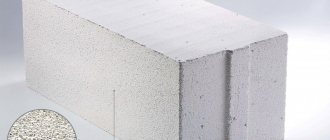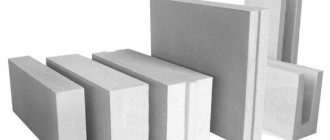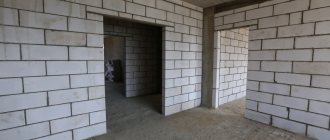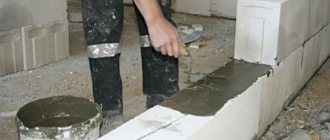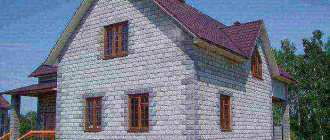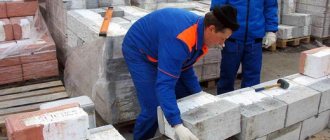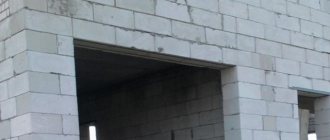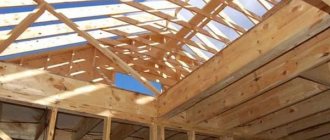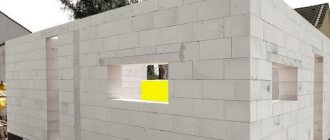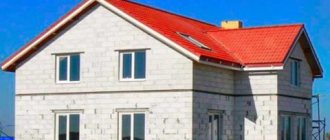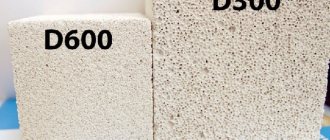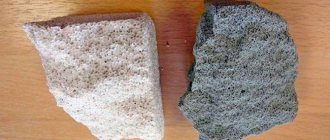More useful articles in the source Go to the channel of the author of the article
Several years ago, my family and I moved to a house built of aerated concrete. Some of my friends have lived in such houses longer than we have, but they did not tell me about the disadvantages of their housing. But in vain. Maybe then I would have chosen a heavier material for construction.
So that you do not repeat my mistakes, I will tell you about the disadvantages of aerated concrete. As it turned out, living in the house is not very comfortable, but first things first.
Humidity
I would say that the most significant disadvantage of aerated concrete blocks is the release humidity.
When blocks first leave the factory, their humidity is sometimes 40%. Then, over the course of several years, the material dries out, and its equilibrium moisture content drops to 5%.
This greatly affects the thermal properties of the walls. The cost of heating a house in the cold season almost doubles. The humidity in the building already increases naturally (wet processes, precipitation, etc.), plus the humidity of the house is initially high.
Fortunately, it is possible to cope with the problem; I came to this conclusion after three years of living in an aerated concrete house. It is necessary to organize good ventilation.
Since indoor humidity levels exceed normal values, residents may freeze. Therefore, many people insulate walls, making a big mistake, because moisture stops freely leaving the material. As a result, the house takes much longer to dry out. This delays the task of finishing the building's exterior
The best option is to make a ventilated facade.
Choosing gas silicate blocks: pros and cons
When choosing materials for building a house, a private developer is guided by several
criteria, the main of which are: low cost , opportunity
quick and relatively easy installation, optimal performance characteristics.
Although the choice of building materials is quite large, in any case it comes down to construction:
- frame-panel type;
- made of brick - ordinary, silicate;
- made of wood, including varieties of wood materials - rounded logs, timber, etc.;
- as an option for private housing construction, a monolithic method of constructing a building can be used;
- from cellular concrete: foam concrete, aerated concrete , gas silicate, etc.
Some requirements for materials for building a house
The main requirements for the future home:
- structural strength;
- creating comfortable living conditions and an ideal microclimate;
- good or excellent thermal insulation characteristics, the presence of which will not only help retain heat in the house, but will also significantly reduce operating costs associated with its heating.
Therefore, the choice in favor of gas silicate is quite justified: an affordable material with good vapor permeability, comparable to the vapor permeability of wood.
This material is strong enough to build houses of 2-3 or even five floors and, according to this criterion, can compete with brick, especially considering the speed of construction and the overall load on the foundation.
Also, the popularity of gas silicate is promoted by the environmental friendliness and naturalness of the raw materials used in the production of blocks.
Artificial stone – gas silicate
Artificial materials are created in order to solve certain problems: to offer the market and saturate it with a product in which there is increased interest (and humanity has never stopped building) or in order to obtain a material with new properties that are most interesting to the consumer.
In this context, the appearance of gas silicate met two criteria and the result was a material that simultaneously has two purposes: being essentially a structural material for construction, it simultaneously, thanks to its porous structure, also performs thermal insulation functions.
In addition, the wishes of builders regarding facilitating installation and reducing the time required to build houses were taken into account. Therefore, in cases where it is difficult for the consumer to choose between a brick and a wooden house, then you can settle on a compromise option and build a house from gas silicate blocks.
Construction of houses from gas silicate blocks: pros and cons
Like any building material, gas silicate has its apologists and fierce opponents. But in order to find out which of them is closer to the truth, get acquainted with the arguments of the first and second.
Material price and construction cost
So, defenders insist that building a house from gas silicate blocks is an option for affordable construction. And they are right, indeed, 1 m³ of blocks costs on average 3000-4000 rubles . In this case, construction is allowed in one row, with a wall thickness of an average of 40 cm, even in a temperate climate zone, without installing an additional thermal insulation layer.
In addition, in their opinion, you can significantly save on foundation construction: since the material has a low specific gravity, it will exert minimal load on the foundation.
Opponents of this material, in a dispute about the low price of the material , present their arguments. Yes, the weight of the material is small, but due to the lack of bending work of the material, a reliable and strong foundation will be required, otherwise problems with cracking not only of the masonry at the seams, but also of the blocks themselves cannot be avoided.
Therefore, you will have to choose between constructing a foundation in the form of a monolithic slab or a strip foundation. The cost of construction will also increase due to finishing work, since not every material is suitable for this, taking into account such technical characteristics of gas silicate as high moisture absorption capacity and poor adhesion of the surface with plasters and putties traditionally used for finishing work.
You should also take into account the fact that gas silicate blocks differ in their density.
As a material for constructing walls, it is recommended to use blocks with a density of D500, the acceptable minimum is D400, and material with a higher density is naturally more expensive.
Thermal conductivity of walls
Often the choice in favor of gas silicate is determined by the low thermal conductivity of the material, which makes it possible not to use additional insulation. But, only if the walls are thick enough to retain heat. Despite the fact that it is claimed that a wall only 35 cm wide and without insulation will provide good protection from severe frosts even, for example, in the Moscow region, this is true only if the cost of heating the house is high.
And if you want to spend the winter warm and at the same time reduce heating costs , the thickness of the external walls should, in this case, be at least 50 cm. Residents of more southern latitudes can afford walls 35-40 cm thick. If the walls are thin, then it is necessary to install a heat-insulating layer, preferably mineral wool, installed on the outside (facade) side.
Vapor permeability of gas silicate and microclimate in the house
This property does not cause heated debate: both opponents and defenders are united. Indeed, the vapor permeability of walls made of gas silicate is comparable to the vapor permeability of a wooden frame.
This feature is explained by the porous structure of the material and its ability, when there is excess humidity in the room, to absorb it and remove it outside the house and vice versa, especially in winter, when the air is dried by heating - it evens out the level due to the increased humidity outside.
But this scheme only works until the owner of the house gets the idea to insulate the house by choosing, for example, polystyrene foam, an absolutely non-breathable material.
House made of gas silicate: easy and fast
- One craftsman spends an average of 15-20 minutes laying 1 m³ of a wall made of gas silicate blocks, instead of the 3-5 hours required for laying a brick wall. Speed is provided by:
- large product sizes, the most common of which is 600×200×300 mm;
- precise geometry of the blocks, the error of which ranges from 0.3 to 0.8 mm;
- the use of special adhesive compositions for gas silicate, instead of cement mortar.
Using glue instead of cement mortar not only allows you to lay out the wall more accurately and quickly, but also contributes to additional thermal insulation of the house, due to its thickness of several millimeters, helping to avoid the appearance of cold bridges. And, despite the fact that glue is more expensive than conventional mortar, several times less of it is required, so construction costs will not increase.
Working with gas silicate is quite simple; for example, if an additional element is needed, it can be easily cut from the whole block with a regular hacksaw or saw. It is also easy to groove blocks for laying reinforcement. But later, when it becomes necessary, for example, to hang a picture or a shelf on the walls, you will need to use special dowels.
The main disadvantages of gas silicate
The most “terrible” disadvantage of gas silicate, like other cellular concretes, is its high moisture and water absorption. Their use in conditions of high (more than 60%) humidity should be limited, but even under normal operating conditions it is necessary to take measures aimed at protecting them from moisture.
First of all, before laying the first row of the wall, it is necessary to install a reliable waterproofing layer between it and the foundation. Subsequently, all walls: external and internal must be finished with materials that will protect them from moisture, the excess of which will lead to brittleness of the material and its further destruction.
Another indisputable disadvantage is associated with the fact that gas silicate is produced exclusively by an industrial method, therefore, it is impossible to organize its production directly at the construction site, as sometimes happens with other cellular concrete: foam concrete, non-autoclaved aerated concrete. Therefore, it will not be possible to reduce the cost of blocks for construction.
Our article will tell you whether it is possible to fill the foundation in winter and how to carry out this work correctly. This article talks about possible foundations for houses made of aerated concrete.
And here you can find out how facing bricks should be laid in a technologically correct manner.
Reviews
Alexey Golovatov, Tver
“To build the house, I chose gas silicate blocks, built from D400, made the thickness of the load-bearing walls 40 cm. Since harsh winters are not uncommon in our country, I decided to insulate the house, for this I built a system of ventilated facades from vinyl siding, and for insulation I used mineral cotton wool A team of builders was working and it was they who suggested that instead of cement mortar it was necessary to buy special glue so that the seams would be of minimal thickness and not create additional outlets for heat. As a result, during the construction season, a two-story house with an area of 250 m² was ready. together with the facade finishing, and in the spring of next year they began finishing work. And now our family has been living in a spacious house for 7 years and during this time no troubles have happened, I haven’t even noticed a single crack.”
Timur Markelov, Izhevsk
“I decided to make my dream come true and build a house outside the city. But I really didn’t want to get bogged down in construction for several years, so I chose between houses made of wood or gas silicate; I didn’t consider the frame-modular option. I gave preference, albeit artificial, to stone and made a lot of mistakes. Firstly, I believed the advertisement and made the outer walls only 30 cm, in the first winter the house practically did not heat up, I had to insulate it - I chose the option of facade finishing from siding and mineral insulation. Secondly, based on the fact that the material is light, the foundation was laid shallow, but it’s good that it was reinforced, so even though cracks appeared in the spring, but only in the seams, the blocks themselves remained intact. The only thing I took into account was the moisture absorption of gas silicate, so I decided not to leave the house without facade finishing over the winter, I plastered it, but this beauty was then hidden behind the siding.”
Grigory Svyatkov, Mytishchi
“My neighbor was building a house from gas silicate blocks, I sometimes helped him with this and also thought that in a couple of years I would build my own, from the same material. Since I saw the whole process, I concluded that working with this material is not difficult, and in addition, it is relatively inexpensive compared to brick or even wooden beams. But a year has passed since my neighbor’s housewarming, and I was disappointed, although, in essence, the problem is not in the material, but in an error related to the fact that it turns out that the masonry should have been laid with glue, and not with mortar. As a result, the house is cold and you will have to incur additional costs for its insulation. In the end, I decided not to take risks and will build my house from profiled timber, as I calculated it won’t be any more expensive.”
Yuri Zagrebelny, Saratov
“In our country, gas silicate is a very popular material, so the question: what to build a house from did not arise for me. But popularity and the ability to work with him turned out to be not the same thing. In addition, I planned to build on piles, but as it turned out, this is not the most correct type of foundation for gas silicate blocks. But it’s good that I managed to learn all these subtleties, as well as many other interesting things, before the start of construction. Therefore, since I did not plan to build a basement under the house, I decided to make a monolithic slab for the base of the house, and entrusted the work to the craftsmen, after looking at the objects they had built and talking with their owners.”
Igor Tretyakov, Stary Oskol
“I built a garage from gas silicate blocks and didn’t have time to finish the façade before winter, but now I don’t believe that the material is completely safe for humans. The wet blocks began to crumble (this is my mistake - I was warned that it has high water absorption), but the smell of lime and other chemicals is very strong, so when planning to build a new house from it, I had already changed my mind - I will do it the old fashioned way from ceramic bricks, for a long time , but reliably."
Kirill Zagrabovich, Klyazma
“I wanted to build my own house, and since I decided to work on my own, without hiring a construction team, I decided to choose gas silicate blocks for this. Besides the fact that the masonry of the walls reminded me of a construction set, the price was also pleasant. In general, it’s decided and done. But I encountered problems even at the foundation stage. As a result, I entered into an agreement with the maintenance crew and everything was done efficiently and on time. As it turned out later, I did everything correctly, since the material has some features that I had no idea about and I still need to be able to work with it. Therefore, you should not save, but you should trust the work to professionals, especially if your own experience in construction is zero.”
Rustam Mansurov, Naberezhnye Chelny
“I would like to warn all those who are planning to build houses from gas silicate blocks. If you choose this material, then give up the basement. There won't be any problems, especially if you do the waterproofing poorly. But even in this case, the process of “pulling” moisture from it in blocks will occur constantly, and accordingly, the house will slowly but surely collapse. But if you don’t believe me, check it out. I'm already convinced."
Fragility of the material
Aerated concrete blocks easily split, and you can easily break off a piece of the wall from a house. If you see a house made of aerated concrete on the street, pay attention to whether there are many chips on it? Surely you will count a large number.
Of course, the exterior decoration hides this flaw, but it still exists.
Fastening problems
Although the problem is not critical, it does exist. Fasteners in aerated concrete hold up worse than, for example, in concrete. Fortunately, the modern selection of fasteners is quite large and varied. If you need to hang something small and light on the wall, then you can screw a self-tapping screw or drive a nail into the aerated concrete.
Minuses
Despite such a significant number of positive properties, gas silicate blocks have certain disadvantages, of which there are also many:
- Low mechanical strength . If you screw in the dowel, the product begins to break down and crumble. As a result, it is impossible to securely hold the fastener. To put it simply, you can install a picture on a wall made of a gas silicate block, but a heavy shelf is unlikely to hang there for a long time.
- Low frost resistance . The manufacturer assures that such a product is characterized by frost resistance of 5 cycles, but there is currently no confirmed data on the durability of the D300 material. You can learn about the size of the block for building a house from this article.
- Increased level of water absorption . Moisture can penetrate into the structure of the block and then have a destructive effect. The result of this process is a loss of strength
- Due to the high level of moisture absorption, liver and fungus can form on the surface of gas silicate walls. In addition, after 2 years, cracks may form in the structure of the material.
- Gas silicate blocks are characterized by a high level of shrinkage , which results in the formation of defects.
- Cement-sand plasters should not be applied to the surface of gas silicate blocks . The reason is that they will not stick firmly to the wall and will simply fall off. There is a solution - this is the use of a gypsum composition, but there is a pitfall here too. Such plaster is not capable of masking existing seams on the wall, and when cold weather sets in, cracks form. The reason is that gypsum plaster cannot withstand changes in temperature and humidity. You can find out what a block measuring 20x20x40 looks like in the description of the article.
- Due to high water absorption, plaster must be applied in two layers . During shrinkage, the resulting finish will form cracks on its surface. They do not affect the tightness, however, they violate the aesthetic beauty. Gypsum plaster adheres well to gas silicate walls and will not fall off even if there are cracks.
You can find out which block to choose for building a house from this article.
The video shows more information about the disadvantages and advantages of gas silicate blocks:
You can find out the thickness of a wall made of expanded clay concrete blocks from this article.
